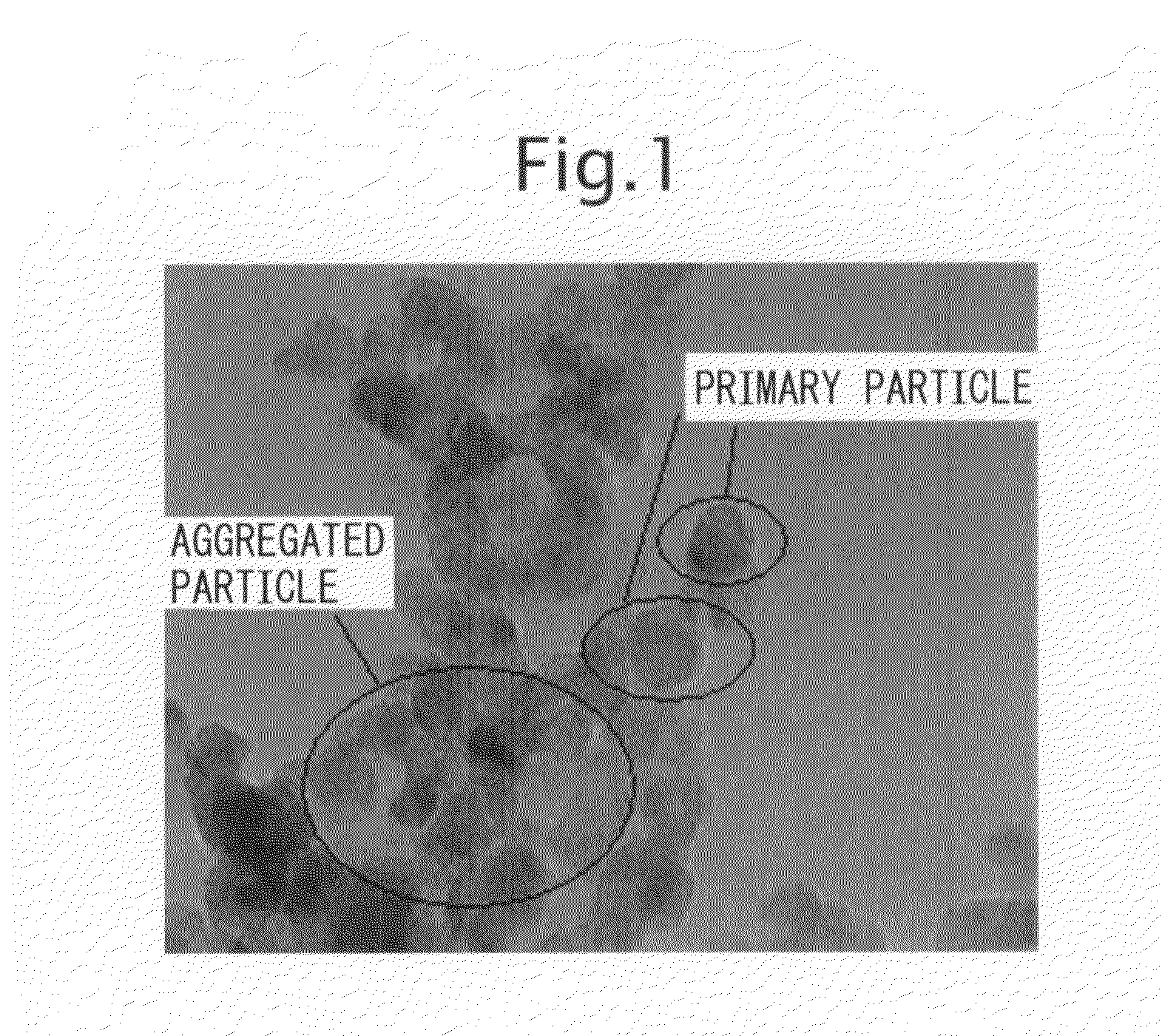Fine Particulate Titanium Dioxide, and Production Process and Uses Thereof
a technology of titanium dioxide and fine particulates, which is applied in the direction of metal/metal-oxide/metal-hydroxide catalysts, physical/chemical process catalysts, cell components, etc., can solve the problems of inconvenient use, non-uniformity of obtained barium titanate in view of particle diameter or quality, corrosion or deterioration of substrates, etc., and achieve excellent primary particle diameter uniformity and low chlorine content
- Summary
- Abstract
- Description
- Claims
- Application Information
AI Technical Summary
Benefits of technology
Problems solved by technology
Method used
Image
Examples
example 1
[0117]A diluted titanium tetrachloride gas prepared by diluting 11.8 Nm3 / hr (N means a normal condition, hereinafter the same) of gaseous titanium tetrachloride with 2 Nm3 / hr of nitrogen gas was preheated to 1,100° C., an oxidative gas prepared by mixing 8 Nm3 / hr of oxygen and 32 Nm3 / hr of water vapor was preheated to 1,100° C., and these raw material gases were introduced into a quartz glass-made reactor where the ratio (S1 / S2) of the cross-sectional area (S1) of the reaction tube and the sum total (S2) of cross-sectional areas of the inlet tubes for the titanium tetrachloride-containing gas and the oxidative gas was 1.5. After introducing a cooling air into the reaction tube so that the high-temperature residence time at 1,150° C. to less than 1,300° C. could be 0.06 second, an ultrafine particulate titanium dioxide powder was collected in a polytetrafluoroethylene-made bag filter.
[0118]The obtained titanium dioxide was passed to a cylindrical rotary heating furnace and dechlorina...
example 2
[0120]A diluted titanium tetrachloride gas prepared by diluting 5.9 Nm3 / hr of gaseous titanium tetrachloride with 30 Nm3 / hr of nitrogen gas was preheated to 1,100° C., an oxidative gas prepared by mixing 4 Nm3 / hr of oxygen and 16 Nm3 / hr of water vapor was preheated to 1,100° C., and these raw material gases were introduced into a quartz glass-made reactor where the S1 / S2 was 1.0. After introducing a cooling air into the reaction tube so that the high-temperature residence time at 1,150° C. to less than 1,300° C. was be 0.04 second, an ultrafine particulate titanium dioxide powder was collected in a polytetrafluoroethylene-made bag filter.
[0121]The obtained titanium dioxide was placed in a hot-air circulation heating furnace and dechlorinated at a heating temperature of 450° C. under the condition that the mass ratio of water and titanium dioxide was 0.04, as a result, D50 of the primary particle diameter was 21 nm, Dtop / D50 was 2.0, the anatase content was 91%, and the chlorine cont...
example 3
[0123]A diluted titanium tetrachloride gas prepared by diluting 4.7 Nm3 / hr of gaseous titanium tetrachloride with 36 Nm3 / hr of nitrogen gas was preheated to 1,150° C., an oxidative gas, prepared by mixing 36 Nm3 / hr of air and 25 Nm3 / hr of water vapor, was preheated to 1,150° C., and these raw material gases were introduced into a quartz glass-made reactor where the S1 / S2 ratio was 2. After introducing cooling air into the reaction tube so that the high-temperature residence time at1,150° C. to less than 1,300° C. was 0.02 second, an ultrafine particulate titanium dioxide powder was collected by a polytetrafluoro-ethylene-made bag filter.
[0124]The obtained titanium dioxide was placed in a hot-air circulation heating furnace and dechlorinated at a heating temperature of 350° C. under the condition that the mass ratio of water and titanium dioxide was 0.06, as a result, D50 of the primary particle diameter was 14 nm, Dtop / D50 was 1.9, the anatase content was 95%, and the chlorine conte...
PUM
| Property | Measurement | Unit |
|---|---|---|
| Temperature | aaaaa | aaaaa |
| Temperature | aaaaa | aaaaa |
| Temperature | aaaaa | aaaaa |
Abstract
Description
Claims
Application Information
 Login to View More
Login to View More - R&D
- Intellectual Property
- Life Sciences
- Materials
- Tech Scout
- Unparalleled Data Quality
- Higher Quality Content
- 60% Fewer Hallucinations
Browse by: Latest US Patents, China's latest patents, Technical Efficacy Thesaurus, Application Domain, Technology Topic, Popular Technical Reports.
© 2025 PatSnap. All rights reserved.Legal|Privacy policy|Modern Slavery Act Transparency Statement|Sitemap|About US| Contact US: help@patsnap.com


